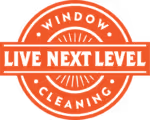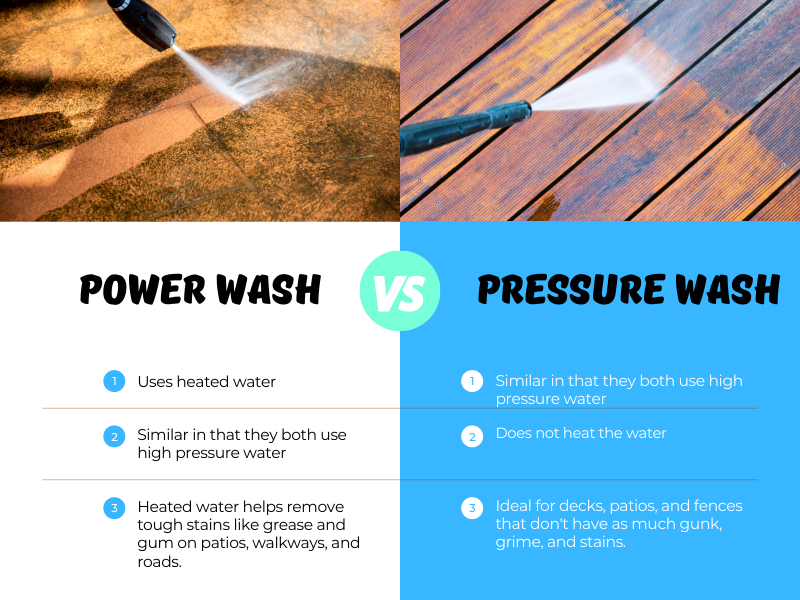Pressure washing and power washing are two cleaning methods that have been around for many years. Although these methods may seem similar, they are actually quite different.
Pressure washing is a cleaning process that uses high-pressure water to remove dirt, grime, mold, algae and other debris from surfaces.
Power washing is a more aggressive form of cleaning that uses hot water to achieve better results over larger areas in less time than pressure washing.
This article will explain the differences between pressure washing and power washing as well as the advantages of each method so you can choose the best service for your needs.
Overview of Pressure Washing and Power Washing
Pressure washing and power washing are two distinct techniques used in the cleaning industry, involving the use of pressurized water to remove dirt, dust, and other debris from surfaces.
Pressure washing is best suited for cleaning soft materials such as wood or vinyl siding. It uses a lower-pressure setting that won’t damage these softer materials while still removing dirt and grime.
Power washing is typically used on harder surfaces like concrete driveways or sidewalks due to its higher pressure setting which can effectively blast away tough stains and debris.
Both methods have their advantages and disadvantages when it comes to chemical impact and environmental impact, so it’s important to understand the differences before choosing one method over another.
When using either pressure or power washing techniques, chemicals are often added into the water stream to help break down grease, oil, mildew, algae, rust, or any other contaminants found on the surface being cleaned.
Pressure washers typically require less chemical usage than power washers since they use a lower pressure setting which does not require as much of a chemical boost for effective cleaning results. On the other hand, power washers require more chemical usage since they need an extra boost in order to do their job effectively.
The amount of chemicals used in both processes has an effect on the environment since leftover residue can make its way into waterways after chemicals come into contact with runoff during cleaning sessions.
It’s also important to consider energy usage when deciding between pressure washing versus power washing for certain jobs; both options can be powered by gas or electricity depending on preference but each type of energy will affect overall cost differently.
Gas-powered machines tend to be more expensive upfront but offer portability advantages while electric machines usually cost less initially but may have shorter run times due to battery life limitations or limited outlets available at certain locations.
Regardless of what option you choose it’s always important to read up about safety protocols associated with both types of equipment before getting started on any project.
Pressure Washing
Pressure washing is a cleaning method that utilizes high-pressure water to remove dirt, debris, mold, and other contaminants from a variety of outdoor surfaces.
It is an ideal choice for cleaning the outside of buildings, driveways, decks, patios, sidewalks and more as it can easily penetrate deep into crevices and difficult-to-clean areas.
Pressure washing is also fast and efficient with minimal disruption to the surrounding environment making it an increasingly popular choice in many areas.
Use of High-Pressure Water
High-pressure water is often used in both pressure washing and power washing techniques as a means of cleaning surfaces.
This high-pressure water can be used to remove dirt, dust, mold, mildew, chalk markings, and other debris from a variety of surfaces with great effectiveness.
The use of high-pressure water requires an understanding of the process and its components.
Water temperature has an impact on the effectiveness and results when using high-pressure water for cleaning purposes, as does the type of nozzle tip being used.
Pressure washers come with various different nozzles that offer different levels of pressure for specific uses.
With the right combination of elements including nozzle tips and temperature settings, it is possible to maximize the cleaning effect while minimizing any damage that may occur due to excessive force or friction.
Ideal for Cleaning Outdoor Surfaces
Due to its high-pressure effectiveness and minimal risk of damage, high-pressure water is an ideal solution for cleaning outdoor surfaces.
The combination of highly pressurized water and expertly applied cleaning solutions can help remove stubborn stains from patio furniture, wooden decks, driveways, siding, and other surfaces quickly and efficiently.
The powerful force of high-pressure water can not only remove dirt buildup but also strip away years’ worth of grime that has been built up due to environmental exposure.
The ability to use the same system for both pressure washing and power washing makes it an attractive option for homeowners who wish to keep their outdoor areas looking like new all year round.
Additionally, using a combination of detergents or chemical stain removers with the pressurized water can provide even more effective results on even the most stubborn stains.
Power Washing
Power washing is an effective method to remove dirt and grime from surfaces; it has been found that power washing can improve the appearance of a surface by up to 90% in some cases.
The water temperature used when power washing needs to be carefully monitored in order to ensure that the surface does not suffer any damage due to thermal shock. Additionally, some cleaning chemicals have been developed specifically for use with power washers and provide excellent results without causing harm or discoloration.
The pressure of the water stream generated by a power washer is typically much higher than what can be achieved with a garden hose, allowing it to quickly and easily break down stubborn stains like grease, oil or paint. This makes it ideal for removing graffiti or other markings as well as deep-seated dirt and grime on outdoor surfaces such as concrete patios, brick walls, driveways or decks. On softer materials such as wood siding, stucco or aluminum siding, the pressure should be adjusted accordingly so that no damage occurs during cleaning.
Power washing can also be used for more delicate tasks such as cleaning windows or vehicles where precision is necessary; special attachments are available which enable users to adjust the width of the water stream so that no damage occurs during cleaning while still achieving excellent results.
In all cases, proper safety procedures should be followed when operating a high-pressure washer including wearing protective clothing and using appropriate eye protection.
Advantages of Pressure Washing and Power Washing
The use of high-pressure water to remove dirt and grime from hard surfaces can provide many advantages, giving a renewed look to the area with minimal effort. Pressure washing, also known as power washing, is one such method that uses pressurized water at temperatures higher than those of traditional garden hose cleaning.
This allows for more efficient removal of stubborn dirt and debris that would otherwise be difficult to remove manually. In addition to the pressurized water, pressure washing may also involve the use of specialized cleaning solutions designed to tackle tough stains or discoloration.
When used correctly, both pressure washing and power washing can offer a number of benefits for homeowners looking to spruce up their outdoor spaces. Pressure washers are able to reach areas that manual scrubbing cannot due to its high-pressure capabilities; this means they can effectively clean areas such as driveways and decks without having to put in extra elbow grease.
Furthermore, using a pressure washer ensures an even and thorough cleanse across all surfaces it touches; the force of the spray can break down any stuck-on gunk in just one go while still being gentle on certain types of materials like wood or concrete.
Pressure washing and power washing have thus become reliable methods for home improvement projects when it comes to outdoor cleaning tasks. By understanding differences in temperature levels and detergent options available for different types of surfaces, homeowners can make an informed decision as to which technique will best suit their needs when it comes time for their next outdoor spring clean.
Choosing the Right Service for Your Needs
Studies have found that pressure washing accounts for about 75% of the total market share in the outdoor cleaning services industry. For individuals who are unfamiliar with these two services, it is important to understand that they both use high-pressure water jets to remove dirt and debris from different surfaces. However, there are some key differences between them.
The main distinction is that power washing uses hot water while pressure washing relies on cold water. This affects the temperature of the detergent used for each service; colder temperatures work best for pressure washing while hotter temperatures work better for power washing.
When choosing between one or the other, it is essential to consider factors such as surface type and size, the amount of dirt that needs to be removed, as well as environmental factors like access to water sources and weather conditions.
Pressure washing requires less water than power washing so it may be a better choice if there are any restrictions on available water resources or if there is a lack of space needed to store hot water tanks. Furthermore, certain surfaces can only be effectively cleaned with either hot or cold water depending on their composition; therefore, selecting an appropriate detergent selection based on this factor can also help maximize efficiency when using either service.
The level of accuracy needed to get desired results should also be taken into account when deciding which cleaning option is best suited for a particular task. As mentioned before, pressure washing utilizes cold temperatures and generally does not require much heat in order to achieve satisfactory results; however higher levels of precision may require investing in additional equipment such as steamers or generators in order to increase heat output for power washing applications.
Conclusion
The right choice between pressure washing and power washing depends on the individual job.
Pressure washing is best for lighter cleaning jobs, such as removing dirt, dust, and pollen from outdoor surfaces.
Power washing is better suited for heavier-duty jobs such as removing grease, oil stains, mildew, and other tough-to-remove substances.
Both services offer advantages that can help you maintain a clean home or business exterior.
With careful consideration of the task at hand, you should be able to determine which service will be most effective in meeting your needs.
Regardless of which service you choose, both pressure washing and power washing have the potential to improve the look and longevity of your outdoor surfaces.




